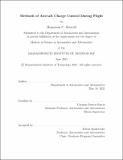Methods of Aircraft Charge Control During Flight
Author(s)
Martell, Benjamin C.
DownloadThesis PDF (50.97Mb)
Advisor
Guerra-Garcia, Carmen
Terms of use
Metadata
Show full item recordAbstract
The accumulation of aircraft electrical charge can impact lightning initiation, cause radio interference, or make it difficult for research aircraft to make accurate measurements of atmospheric electric fields. Two experimental campaigns are described in this thesis that relate to the control of net electrical charge on aircraft, and the associated physical phenomena. First, a successful flight demonstration of actively controlled charging in fair weather conditions is described. A corona discharge wire is used for remote charging of a 1.9 m wingspan plane to both positive and negative polarities. By applying a voltage between -13 and +13 kV to the wire, the plane charged to +23 and -30 kV, respectively. The system demonstrates comparable results to previous modeling and wind tunnel experiments, which showed an increase in plane potential and a decrease in corona current as wind speed increased. There are technological limitations to the charge control strategy, such as a saturation voltage due to spurious corona and the delicacy of the corona wire. The second experiment is the study of the behavior of streamer corona discharges in wind. A point-to-plane geometry is used to provide a baseline to compare to precipitation static (p-static) dischargers, which are in use on most airplanes today. We find that the discharge characteristics are strongly influenced by the wind: the frequency of pulsations and the average current increase with wind speed, but both become less consistent. In general, two types of streamer bursts emerged upon adding wind: first, the streamers tended to point with the wind especially at lower wind speeds and higher voltages; at higher wind speeds and lower voltages, the streamer bursts tend to point against the wind. To the authors knowledge, this phenomenon has not been experimentally observed before.
Date issued
2021-06Department
Massachusetts Institute of Technology. Department of Aeronautics and AstronauticsPublisher
Massachusetts Institute of Technology